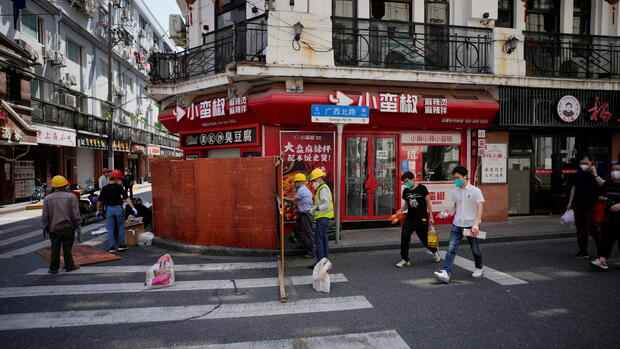This is shown by the Purchasing Managers’ Indices (PMI) for the manufacturing and services sectors, which were released on Tuesday. These are the first economic indicators for the month of May.
The manufacturing PMI rose to 49.6 points in May, according to the National Bureau of Statistics. In the previous month, it had fallen to its lowest level since the pandemic began at 47.4 points. The service sector index improved from 41.9 to 47.8 points.
A value greater than 50 indicates that a sector is growing. A reading below 50 signals a decline. The state-determined PMI primarily reflects the assessments of large and state-owned companies and is collected monthly through surveys.
The data for small and medium-sized manufacturing enterprises, which provide a large part of China’s jobs, is collected by business magazine Caixin and released on Wednesday.
Relaxation of the corona measures in many cities
The better mood in the management floors of Chinese companies reflects the easing of the corona measures in numerous cities. According to a recent analysis by the consulting firm Gavekal Dragonomics, the sometimes massive corona restrictions in numerous Chinese cities were gradually relaxed from mid-April. Analyst Ernan Cui sees a “gradual decline in the nationwide wave of lockdowns.”
China is sticking to its zero-Covid strategy.
(Photo: dpa)
This is also shown by the mobility data. According to an analysis by the French investment bank Natixis, traffic between cities recovered in May. This had previously come to a standstill in many places because local authorities blocked roads for fear of infections and did not allow truck drivers to pass. This put a strain on numerous supply chains, some of which came to a standstill.
Many factories had to shut down their production because important primary products were missing. In ports, clearance stopped because the goods were not delivered or delivered. The current easing could contribute to a “recovery in the supply chains and thus among the manufacturers,” according to the study.
There is now also an opening plan for the financial and economic metropolis of Shanghai. From Wednesday onwards, the lockdown that has been going on for two months is to be essentially lifted in the economic and financial metropolis, which is home to around 25 million people.
The number of new corona infections is falling
On Monday, the number of new infections in China fell below 100 for the first time since early March after months of strict corona restrictions. However, the high level of contagion from the omicron variant and China’s adherence to the zero-Covid policy means the easing may be temporary.
This means that even in the case of individual corona cases, entire buildings or even districts are sealed off. Roland Rohde from the federally-owned company for foreign trade and location marketing (Gtai) said that the local authorities knew that they would be sanctioned if the pandemic got out of hand he.
Hardly any economist still expects that China will be able to achieve the self-imposed growth target of 5.5 percent in the current year. The International Monetary Fund expects growth of 4.4 percent.
The investment banks Bank of America, Barclays and UBS expect an increase of 4.2 percent, Nomura only 3.9 percent. The first Chinese experts even warn that it will be difficult to reach the growth rate of 2020, up 2.3 percent.
>> Read here: Stock crash, growth slump, lockdown madness – the China crash
Last week, China’s Prime Minister Li Keqiang warned more clearly than ever before that the domestic economy would collapse: the world’s second-largest economy is currently in some respects worse than it was in 2020 after the first outbreak of the pandemic, the head of government said at a video conference with apparently more than hundred thousand representatives of local governments, state-owned companies and financial institutions.
Rising unemployment is a concern for the government
Such an emergency meeting is extremely unusual and shows how concerned parts of the Chinese government are that the economy will be severely affected by the strict corona measures. Li is particularly worried about the sharp rise in unemployment. He therefore urged the cadres to do more to combat them.
Many supply chains have broken off due to the corona restrictions.
(Photo: dpa)
The head of government, who will leave office in autumn, has repeatedly pointed out the economic damage caused by the zero-Covid strategy in the past few weeks. On the other hand, head of state and party leader Xi Jinping, who wants to remain in office, always emphasizes that combating the pandemic has top priority.
The German economy is also feeling the effects of the problems in the supply chains more and more. According to a survey by the Ifo Institute, the shortage of materials in industry has worsened due to the situation in China. Almost all key industries are severely affected.
In May, 77.2 percent of companies complained about bottlenecks and problems in procuring preliminary products and raw materials. Around every second company suffering from material shortages said that the current lockdowns in China had made the situation even worse. The automotive industry in particular is affected here.
Mechanical engineering is also feeling the effects of the delivery bottlenecks. The president of the industry association, Karl Haeusgen, warned in an interview with the “Welt am Sonntag” that “the China lockdown is having a much more severe impact on us than the Russian war of aggression.”
The companies lacked semiconductors and other electronic components, but the situation was also getting worse for metals and plastics. Therefore, the production forecast, which has already been lowered, is no longer tenable.
More: The Perfect Storm – How Bad Will the Crisis Be for the Global Economy?
